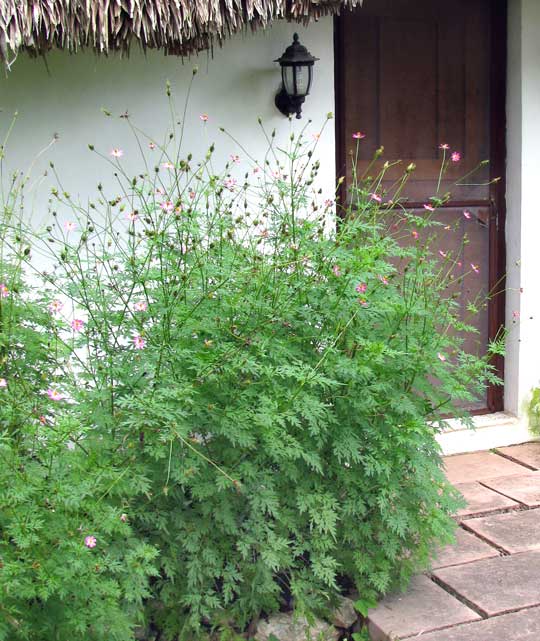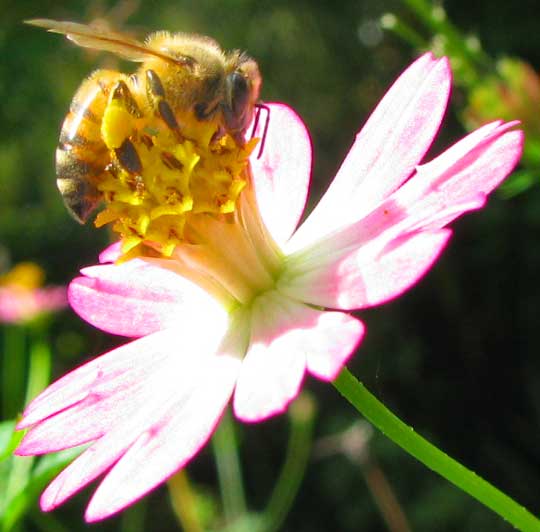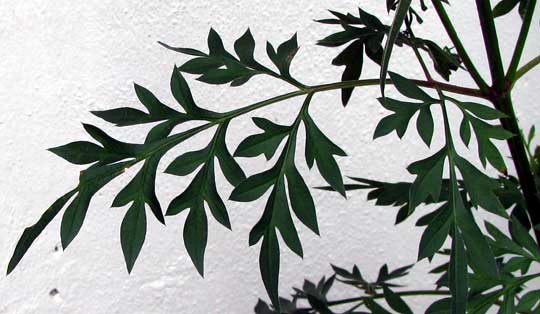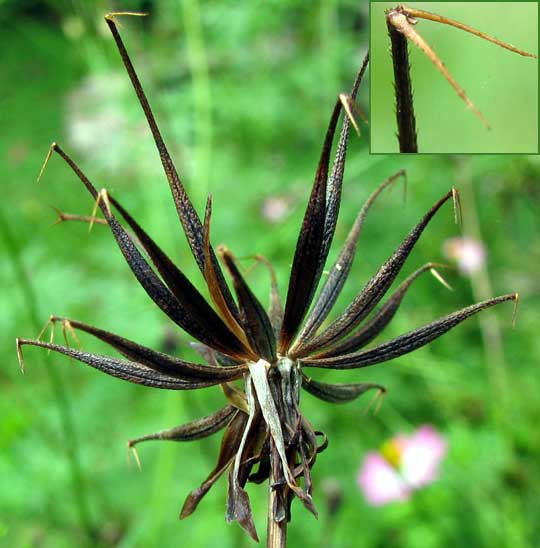Excerpts from Jim Conrad's
Naturalist Newsletter
from the August 8, 2010 Newsletter issued from Hacienda Chichen Resort beside Chichén Itzá Ruins, central Yucatán, MÉXICO; limestone bedrock, elevation ~39m (~128ft), ~N20.676°, ~W88.569°
AN EDIBLE COSMOS
Next to one of Hacienda Chichen's bungalows a rose-pink-flowered, ferny leafed member of the Composite Family luxuriantly grows over six feet tall, as shown below:

You can see an inch-broad (2.5 cm) flower head below:

The opposite, ferny, pinnately lobed leaves are shown below:

The deeply pinnately lobed leaves, the long-stemmed heads, the pink "ray flowers" surrounding the yellow "disk flowers" in the heads' centers, and the way the pink ray flowers are "toothed" at their tips, all may remind you of the common garden Cosmos, and in fact this is a Cosmos, COSMOS CAUDATUS. However, this species is found in few Northern gardens, since it prefers the tropics.
Cosmos's fruiting heads are dark, spiky affairs that most people say detract from the plant's beauty, but they're worth looking at. You can see a head below:

Northern wildflower fanciers might see the similarity between this fruiting head and those of Spanish Needles, genus Bidens, which in late summer and fall up North often create brightly yellow fields and roadsides. You can see a fruiting head of a Bidens similar to our cosmos, one living here in the Yucatan, at www.backyardnature.net/yucatan/bidens3.jpg.
Notice that the "needles," or awns, atop the Bidens/Spanish Needle fruits stick upward, while those of our Cosmos are backward-pointing. If you've only seen Spanish Needle awns, these hooked-back ones of Cosmos caudatus look very strange.
About 26 tropical and semitropical species of the genus Cosmos are recognized, all being native to the Americas, with Mexico seeming to be the center of evolution, hosting the most species. Cosmos caudatus is one of those species that's so pretty that it's planted throughout most of the world's tropics.
In fact, Cosmos caudatus may be more popular in Southeast Asia than it is here in its Mexican homeland. In Southeast Asia often it's called Ulam Raja, which literally means "King's Salad." The plant was carried by the Spaniards from Mexico to the Philippines, from where it spread to the rest of Southeast Asia. The word Ulam is Malay and is used to describe a preparation that combines food, medicine and beauty. In that part of the world Cosmos caudatas is a widely popular herbal salad.
Learning this I made a return trip to the plant beside the bungalow, found some young sprouts, and tasted them. The taste reminded me of the overpowering, pungent and not altogether agreeable odor of crushed marigold leaves. I won't be adding this to my salads.
However, juice of the plant is considered to have anti-fungal and anti-bacterial effects. The Malay people believe that the herb is good for health and contains anti-aging properties, that it enhances blood circulation, strengthens the bones and promotes fresh breath.